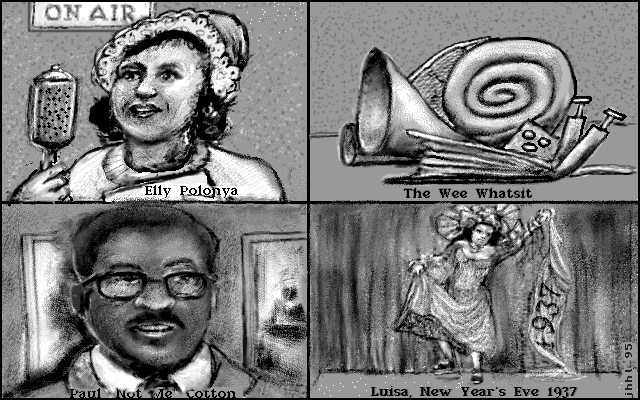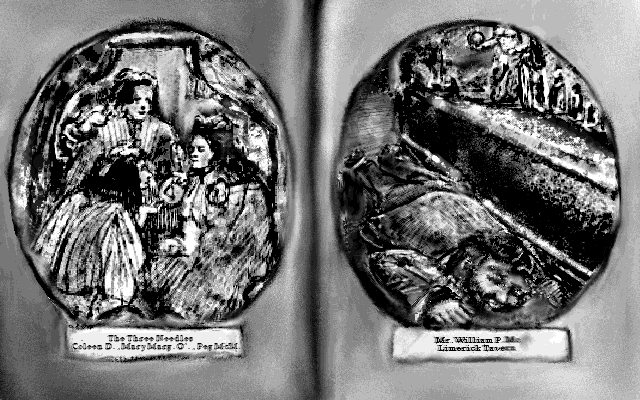Wednesday, September 30, 2009
Cozy Studio
In New York City, Real Estate is an emotion more powerful than Love - ask any number of pitiful split-up couples who are still living together. Here you peruse the Classified section and watch as real estate agents with the demeanor of piranhas battle for a percentage of your meager rent.
The Classifieds are written in a strange language of abbreviations and some have been influenced by a peculiar version of "product placement." For years, Mayor Edward I. Koch made discreet payments so that all apartments with Eat In Kitchens had the initials "EIK" in the ad. Defunct Radio Station WBFP, a lite-rock 70's monstrosity, similarly paid for its call letters to be displayed for apartments with wood burning fireplaces. But there were other abuses of the English language, and the prime offenses are the codewords "Luxury" and "Cozy." Luxury should mean it has a working elevator to the wine cellar and at least two maids' rooms. It actually means "recently painted, but still overpriced." "Cozy," which brings to mind a little bungalow-by-the-sea, fresh scones and cocker spaniels, actually means "tiny."
How tiny? Let's look at this little number on Thompson Street. After walking up three floors (watch the banister), the agent unlocks the four locks, and pulls the door ("Watch It!") suddenly. A Murphy bed leans out of the doorway and comes to rest with a two inch clearance in the hall. On a little recessed shelf: a hotplate, a chamber pot and a seltzer bottle. Cozy!
Or look at this one, around the corner on Sullivan St. A brisk stumble down the basement stairs and over some piled-up two-by-fours to a rough hewn door, guarded by a Master lock. Inside, a matress is sprawled on a coal pile. A few empty cans of Sterno are strewn about. Cozy! But watch out for the pneumonoultramicroscopicsilicovolcanoconiosis!
So, when I got to this one, an attic on 24th street in a former stable, I took it. Though accessible only from a trap door, it was relatively spacious. My diminished stature and habit of going shoeless was an advantage because of the six-foot-nothing ceiling. The window gave me a view and smell of the refuse strewn backyard of an Indian restaurant. But it was worth it because it measured nearly 1000 square feet. Or would have been if there weren't so many old trunks and wallpaper rolls. But it was cozy.
As I pulled out the futon for my first night's rest, I found that I had to move some of these old remnants aside. The natural tilt to the building aided me in this effort! There were a great number of noises - both muffled and clear - which seemed to be coming from the ghosts of the horses in the long-empty stable. I could hear the creak of the Third Avenue El train, which was torn down in 1953. With a mighty lurch, one of the rolls went off by itself, indicating that the tilt in the floor had shifted! New, more close at hand noises put me in a state of unease. Making a quick decision as to which of my three cats I would carry out, kick downstairs or leave to their fate, I ran out of the rickety building, which, in a matter of minutes collapsed into the street.
Radio Schizo

The year was 1939, and radio was hot, hot, hot! It burned up years of Vaudeville material in a matter of weeks, forcing the industry to look for more stable situations - continuing comedies and soap operas, larded with variety show antics. And for a small number of specialists, it was an especially hectic time - because they were often required to be in two or three different studios at the same time, or nearly so.
Case in point: Andy McCorkle, who had invented a bagpipe-based sound effects machine, which he called the Whatsit. Actually, there were two Whatsits: the Grand Whatsit, which could produce the sound of a collapsing elephant, force 3 hurricane, Army mess hall, gushing oil well or inflating Zeppelin, while the Wee Whatsit made the sound of a snoring aardvark, a baby hiccough, galoshes or Cream Of Wheat (that last one paid most of the bills). Andy had special cases built for the Whatsits which fit exactly on the jump seats of the old Checker cabs, God bless 'em. And they were put to good use as he sped around town from job to job during radio prime time.
Another case: Elly Polonya, "The Goo Goo Girl," who could play any baby voice part from 5 down to preemie convincingly. Elly always carried a bottle of kraut juice with her to help constrict her larynx before a job. Her baby impressions of world political figures could always be counted on to stop a show dead.
And Paul Cotton, a negro performer, popped up on several shows with his distinctive catch phrase "Not Mee!!," in a high, whispery, resigned, and pleading voice which could not be imitated. On a good night you could hear him say it on five different shows across the dial!
Not to mention Luisa Verdejo, born Louise Greenberg, whose act consisted of spectacular singing in swing triple-time Spanish double-talk! Doctoral students at Julliard are still studying old V-Disks of her act in amazement. Her nickname was "The Singing Castanet(te)."
It just so happened that one night, all four of these troupers showed up together in two different skits in two different shows!
Show number 1: at 7:30PM, "A Date with Dolores [ed.: Franco, now forgotten],", where Luisa had a secondary role as Dolores' dotty cousin Clara. In this episode, Dolores is babysitting for Baby Maria (Elly P.) when Clara comes in singing an insane lullaby "Cuando Las Cucarachas No Pueden Salir" - which has the perverse effect of attracting a small army of dance crazy roaches (The Wee Whatsit). The women stand on chairs screaming for help, and Henry, the super (Paul C.) pops in and says, "Not Meeee!" Baby Maria eats the roaches and all is well!
An hour later, the four were working together again in "Harmony Hall," with Eddie Doucet as Jud, the dim-witted but good-natured head of the Fraternal Order of the Celestial Harmonies, whose frog-like speaking voice masked a surprising ability to croon. In this episode, Jud mischievously takes his nephew, Percy (Elly P.) out to the burlycue show to keep him from becoming a "nancy boy." Luisa, playing the star of the show, explains that her specialty will be a sinuous dance ending with a dive into a giant bowl of flan (The Grand Whatsit). After her spectacular dive, she starts to drown in the sweet Spanish custard. The call for help goes out ("Not Mee!" says Henry, the stage manager (Paul C.)), but Percy saves the day by eating the flan.
East Side Story
Near the end of the last century it was common for formerly isolated ethnic groups to come into contact with each other. Usually, they realized that they were all recent immigrants and shed their Old World prejudices, but there were two neighboring ethnic groups which for some reason just couldn't stop fighting each other. The Belgians, brought over to lay the Belgian blocks and to tend the Brussels Sprouts farms - in what is now East Harlem - were the bitter rivals of the Welsh, who were imported to cook their fabled rarebits and to dig the still unfinished East Side subway lines.
The Welsh formed gangs which could be seen marching in the streets with leeks on pikes, singing songs of solidarity in their consonant filled native tongue, while the Belgians strutted around with ferocious white Scotty dogs at their sides, puffing themselves up with quilted jackets, which gave rise to their nickname: the hot-air Walloons. The spirited turf wars between these two ethnic groups, which left the streets filled with shredded vegetables, were looked on with exasperated puzzlement by their more accommodating neighbors, the Bavarians, the Tuscans and the Icelanders.
Ah! But love will find a way: a young Welsh miss, Gwynyth Pother and a Belgian lad, Andrian Mecke found each other over a bowl of cock-a-leekie and woke the next morning to a breakfast of Belgian Waffles. The rival families were furious. The Belgians built a roadblock in the middle of 101st street with their Belgian blocks, while the Welsh marched around playing their bagpipes and crwths hoping to break down the walls Jericho-style. Gwynyth and Andrian simply ran off to the Village, where their somewhat dim-witted kinsmen never thought to look for them.
Hostilities continued for several more weeks until the two rivals buried the hatchet and concentrated on ousting a new immigrant group: the Maltese, who came over with their recipes for Malted Milk.
Speaker's Corner
Union Square is now renowned for its Greenmarket and the subway station with the prerecorded paternoster:
"Attention all passengers! Please stand clear of the moving platform as trains enter and leave the station. Thank you!"
But in earlier days, it was the focal point for demonstrations and soap-box speeches. It was also the theatrical district, so there were always plenty of crowds to preach to ; the same situation pertains in Times Square today.
As time went on and the crowds increased, being heard over the throng was a considerable challenge. Stepping in to remedy this problem was Allard Ochsenberg, an Alsatian clockmaker, who invented a solution for this: the pay megaphone! You'd put a penny in and get 15 minutes of megaphone use before a felt shutter deep in the device would cut you off. The megaphones were made of cast iron, mounted on gimbals so the voice could be directed at passing shoppers. Similar devices, with binoculars, are used for sightseeing to this day!
A battery of eight of these megaphones were installed on the west side of Union Square, where today used books are sold. When all stations were occupied, the peculiar acoustic properties of the devices made it seem like tuning through a dense patch of talk-radio programs!
The pay megaphones were removed during the Second World War and symbolically sold as scrap.
The Gay Nineties

